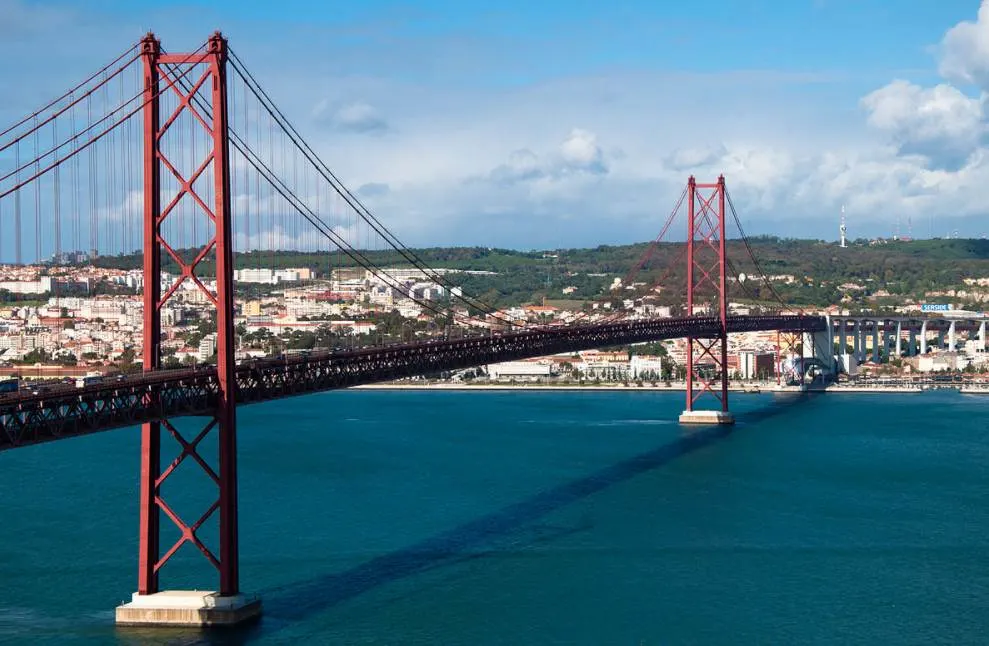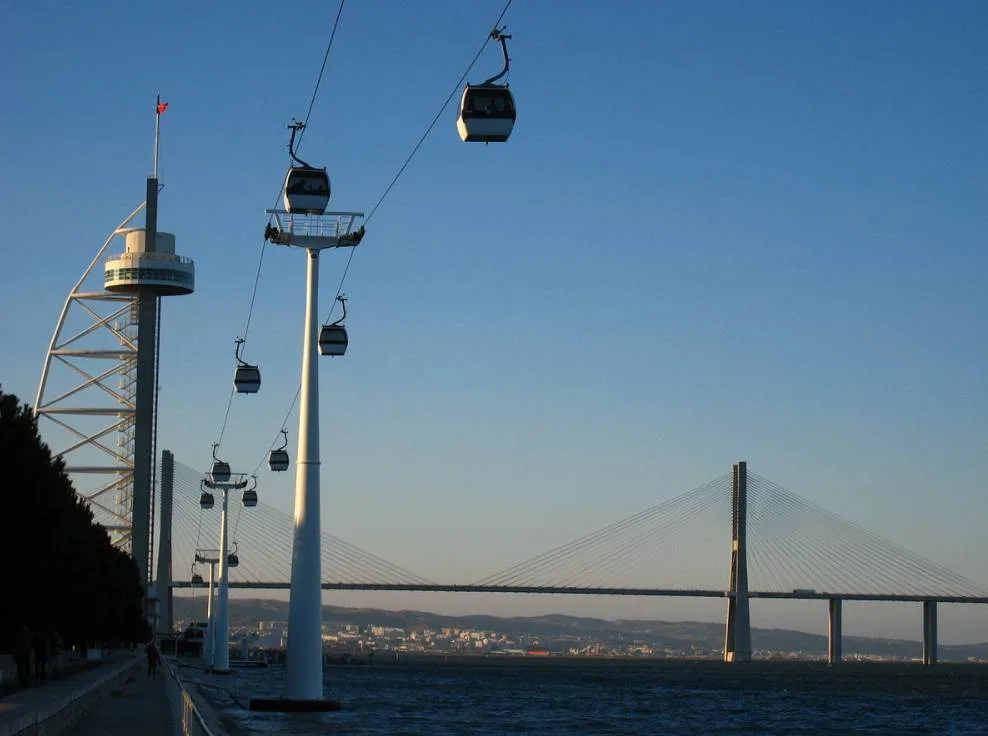When one of the busiest bridges in Portugal became so congested with traffic, another astounding bridge was built to solve the problem. This bridge not only solved an immense problem but holds a remarkable record as well.
Let’s take a closer look at some of the most interesting facts about the Vasco da Gama Bridge, an incredible architectural masterpiece for multiple reasons.
1. It spans the Tagus River in the Portuguese capital of Lisbon
The Vasco da Gama Bridge is an enormous cable-stayed bridge that crosses the Tagus River in Lisbon. This is the longest river on the Iberian peninsula with a length of 1,007 kilometers (626 miles) and originates in the Montes Universales mountain range just east of Madrid.
The city was built near the mouth of the Tagus River which means it’s pretty wide here. The bridge connects the Sacavém neighborhood in the northern part of Lisbon with the towns of Alcochete and Montijo. Lisbon Airport, officially known as “Humberto Delgado Airport, is just located just southwest of the bridge.
The historical heart of the city where you can find all the historic landmarks is located just a few kilometers south of the bridge. This means that it provides amazing views of the city looking south.

2. It was built in just 3 years during the 1990s
The construction of the bridge started in February of the year 1995 and was remarkably already completed just over 3 years later in March 1998. It officially opened for traffic on March 29, 1998, a historic day for the city of Lisbon.
One of the main reasons that the strict schedule was maintained was that the year 1998 was the year that Expo 98 was held in Portugal’s capital. This was a special event that commemorated the 500th anniversary of Vasco da Gama’s discovery of a trade route to India.
Vasco da Gama (1460s-1524) was a Portuguese explorer who is arguably one of the most famous people in Portuguese history. His route along Cape of Good Hope in South Africa established a permanent connection between the East and the West.
This is also the reason why the area around the bridge is referred to as the “Parque das Nações,” commonly known as “Expo.”

3. It’s the longest bridge entirely within Europe

although the Crimean Bridge or “Kerch Strait Bridge” is even longer, the Vasco da Gama Bridge holds the record of being the longest bridge entirely located within Europe.
The bridge has the following dimensions:
- Total length: 12.345 kilometers (7.671 miles)
- Longest span: 420 meters (1,378 feet)
- Width: 30 meters (98 feet)
- Maximum height: 148 meters (486 feet)
The Crimean Bridge has a railroad bridge with a length of 18.1 kilometers (11.2 miles) while the road bridge has a length of 16.9 kilometers (10.5 miles).

4. It’s the second bridge that crosses the Tagus River in the city
Before this massive structure in the northern part of the city was completed, all the traffic going from the northern part of Portugal to the southern part had to pass through the city of Lisbon. This caused major congestion on the roads of the city.
There was only one bridge to cross the Tagus River in Lisbon as well called the 25 de Abril Bridge. This equally impressive bridge looks similar to the Golden gate Bridge in San Francisco but was completed about 3 decades later in 1966.
It was originally known as the Salazar Bridge but renamed to 25 de Abril Bridge following the Carnation Revolution which overthrew the Salazar Government.

5. The bridge was built to sustain extreme calamities
The engineers constructing the bridge were aware of the fact that Portugal is prone to earthquakes. This is emphasized by the flattening of the city during the 1755 Earthquake.
This calamity had an estimated magnitude of 8.5 to 9 on the Richter Scale which is quite severe, and the bridge can sustain an earthquake even much stronger than this. It can also withstand winds of up to 250 kilometers per hour (155 miles per hour) which is the equivalent of a super hurricane.
That’s why the foundation of this massive bridge was built on an epic scale. The deepest supporting columns have a diameter of 2.2 meters (7.2 feet) and were driven into the ground at a depth of 95 meters (312 feet) below mean sea level.
Regardless of these extreme precautions, it’s certain that the bridge will have to be renovated after 120 years as this is the life expectancy of the structure.

More interesting facts about the Vasco da Gama Bridge
6. 7 roads allow access to the bridge, including 4 viaducts. The south viaduct has a length of 3.825 kilometers (2.38 miles) while the south access roads have a length of 3.895 kilometers (2.42 miles) including the toll plazas.
7. The massive project cost an astounding $1.1 billion, a number that was shared by 4 different consortiums that took care of one specific task.
The overall consortium that operates the bridge for the first 40 years is called “Lusoponte” and consists of 50.4% of Portuguese companies, and 24.8% each of French and British companies.
The tolls received for the first 40 years will repay the construction and earn money for these companies (which will be a handsome amount considering the daily traffic on the bridge).

8. Regardless of the construction of the second bridge, The 25 de Abril Bridge remains one of the busiest bridges in the world with well over 100,000 vehicles crossing it every day on average.
The Vasco da Gama Bridge is less crowded but still sees over 50,000 vehicles cross it every day according to 2020 data.
9. Crossing the Vasco da Gama Bridge is more expansive than crossing the 25 de Abril Bridge. Both bridges only charge toll when traveling northbound (into the city of Lisbon).
Crossing the newest bridge costs anywhere between €2.85–€12.2 while crossing the 25 de Abril Bridge only costs a flat fee of 1.85 €.

10. Apart from the Vasco da Gama Bridge, multiple other structures have survived from the World Fair that took place in 1998. One major attraction in the vicinity of the bridge is the Casco da Gama Tower and a cable car ride.
This amazing tower dominates the shoreline of the Tagus River in the northern part of Lisbon and resembles the Burj Al Arab in Dubai and the Spinnaker Tower in Portsmouth.
Other attractions in the Parque das Nações are the Lisbon Oceanium, the Altice Arena, the Vasco da Gama Mall, and the Portugal Pavilion. More than enough to spend an enjoyable day in Portugal’s capital.

